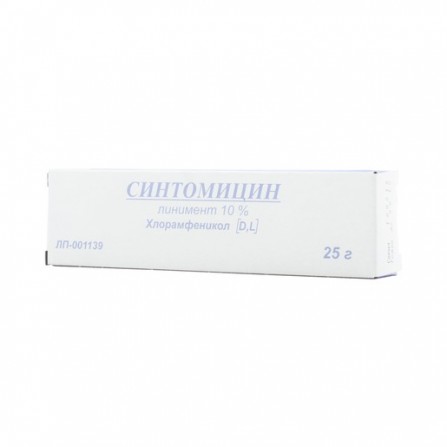Syntomycin liniment 10% 25g
Condition: New product
999 Items
Rating:
Be the first to write a review!

More info
Active ingredients
Chloramphenicol
Release form
Ointment
Composition
1 g of liniment contains: Active substance: chloramphenicol 100 mg. Auxiliary substances: castor oil - 20 g, emulsifier No1 (Lanette Esix) - 5 g, sorbic acid - 0.2 g, carmellose sodium - 1.98 g, purified water - up to 100 g
Pharmacological effect
Broad-spectrum antibiotic. The mechanism of antimicrobial action is associated with impaired protein synthesis of microorganisms. It has a bacteriostatic effect. Active against gram-positive bacteria: Staphylococcus spp., Streptococcus spp .; Gram-negative bacteria: Neisseria gonorrhoeae, Neisseria meningitidis, Escherichia coli, Haemophilus influenzae, Salmonella spp., Shigella spp., Klebsiella spp., Serratia spp., Yersinia spp., Proteus spp., Rickettsia spp. is also active against Spirochaetaceae, some large viruses. Chloramphenicol is active against strains resistant to penicillin, streptomycin, sulfonamides. The resistance of microorganisms to chloramphenicol develops relatively slowly.
Indications
For oral administration: infectious and inflammatory diseases caused by microorganisms sensitive to chloramphenicol, including: typhoid fever, paratyphoid fever, dysentery, brucellosis, tularemia, whooping cough, typhus and other rickettsioses; trachoma, pneumonia, meningitis, sepsis, osteomyelitis. For external use: purulent skin lesions, boils, non-healing trophic ulcers, II and III degree burns, nipple cracks in nursing women. For local use in ophthalmology: inflammatory eye diseases.
Contraindications
Blood diseases, marked abnormal liver function, deficiency of the enzyme glucose-6-phosphate dehydrogenase, skin diseases (psoriasis, eczema, fungal diseases); pregnancy, lactation, children up to 4 weeks (newborns), hypersensitivity to chloramphenicol, thiamphenicol, azidamphenicol.
Precautionary measures
Application for violations of liver function. Contraindicated for severe violations of liver function. Application in children Chloramphenicol is not used in newborns, because possible development of gray syndrome (flatulence, nausea, hypothermia, gray-blue skin color, progressive cyanosis, dyspnea, cardiovascular failure).
Use during pregnancy and lactation
Chloramphenicol is contraindicated for use during pregnancy and lactation (breastfeeding).
Dosage and administration
Individual. When ingestion dose for adults - 500 mg 3-4 times / day.Single doses for children under the age of 3 years - 15 mg / kg, 3-8 years - 150-200 mg; over 8 years old - 200-400 mg; frequency of use - 3-4 times / day. The course of treatment is 7-10 days. When applied topically, put on gauze tampons or directly on the affected area. From above apply a usual bandage, it is possible with parchment or compress paper. Dressings are made depending on the indications in 1-3 days, sometimes in 4-5 days. They are used locally in ophthalmology as part of combined preparations in accordance with the indications.
Side effects
From the hemopoietic system: thrombocytopenia, leukopenia, agranulocytosis, aplastic anemia. On the digestive system: nausea, vomiting, diarrhea, flatulence. On the side of the central nervous system and peripheral nervous system: peripheral neuritis, optic neuritis, headache, depression, confusion, delirium, visual and auditory hallucinations. Allergic reactions: skin rash, urticaria, angioedema. Local reactions: irritant (with external or local use).
Interaction with other drugs
With simultaneous use of chloramphenicol with oral hypoglycemic drugs, hypoglycemic effect is enhanced by suppressing the metabolism of these drugs in the liver and increasing their concentration in the blood plasma. When used simultaneously with drugs that suppress bone marrow hematopoiesis, there is an increase in the inhibitory effect on bone marrow. erythromycin, clindamycin, lincomycin, a mutual weakening of action is noted due to the fact that chloramphenicol can displace these drugs from the bound state or prevent their binding to the 50S subunit of bacterial ribosomes. If they are used simultaneously with penicillins, chloramphenicol counteracts the manifestation of the bactericidal action of penicillin. , slowing down the excretion and increasing their concentration in the blood plasma.
special instructions
Chloramphenicol is not used in newborns, becausepossible development of gray syndrome (flatulence, nausea, hypothermia, gray-blue skin color, progressive cyanosis, dyspnea, cardiovascular insufficiency). With caution used in patients who have previously received treatment with cytotoxic drugs or radiation therapy. With simultaneous intake of alcohol may develop disulfiramopodobnoy reactions (skin hyperemia, tachycardia, nausea, vomiting, reflex cough, convulsions). In the process of treatment, systematic monitoring of the pattern of peripheral blood is necessary.




